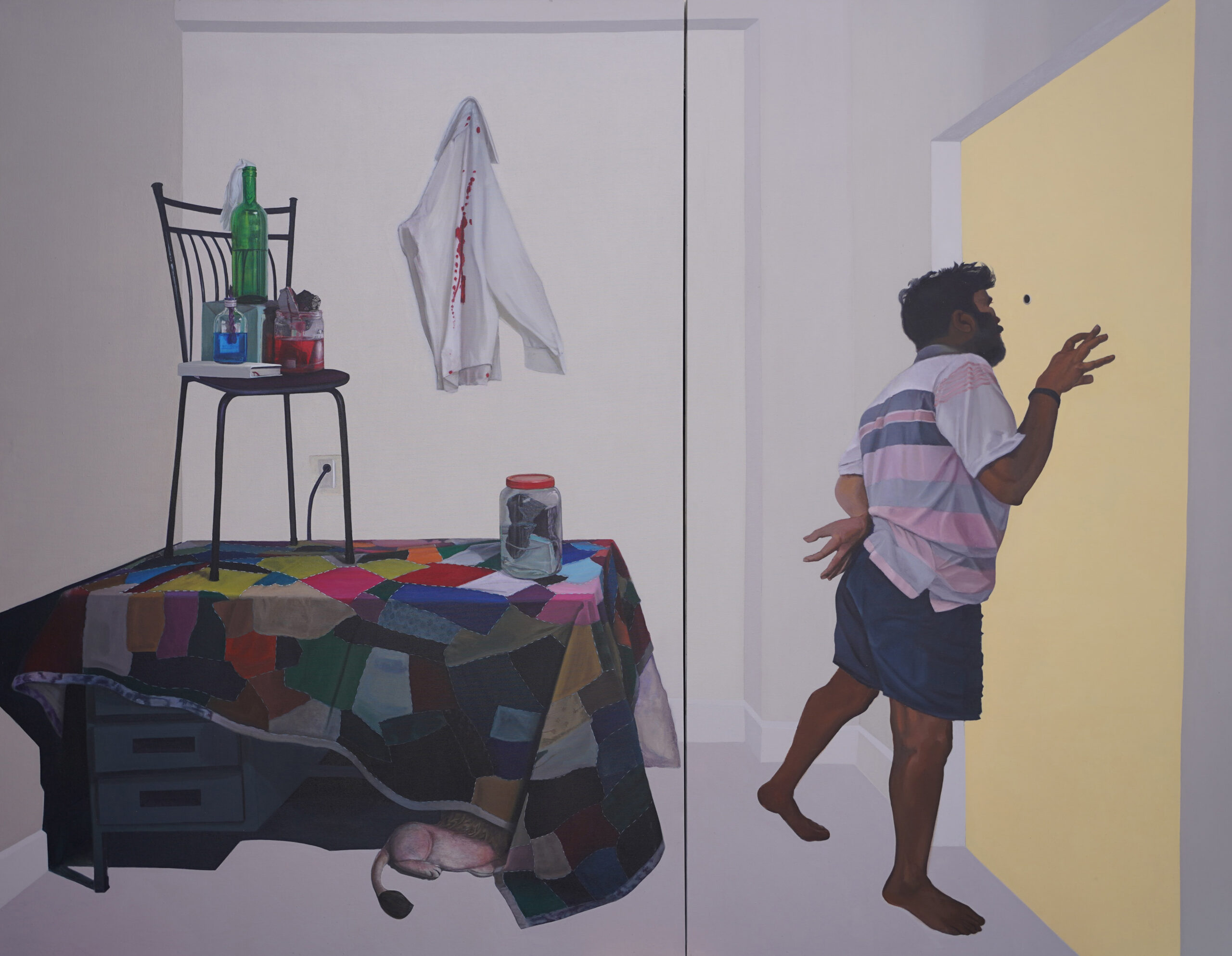Still Life
Still-life is considered as a work of art depicting mostly inanimate subject matter typically commonplace objects which are either natural or man-made.
Still-life as a subject matter has always interested artists not only to understand the physicality of an object but also how that object becomes an extension of our body and memory. But how does an artist standing at present looks at an object and stillness both physically and conceptually?
Santosh’s large 7’x9′ acrylic on Canvas painting named ‘Still life’ is a confluence of memories, experiences, and realities. But the question here is what kind of stillness is the artist referring to? Is it just the visual stillness or this stillness is to identify the sudden pause we all are going through. The multiple encounters that the artist is trying to narrate through all these stilled objects and gestures do this lead us towards the stillness before a storm or all these objects with encoded meanings are the result of a huge storm. This large autobiographical painting of Santosh travels between the duality of past/ memories and present/experiences.
The artist as protagonist introduces himself in the painting making a gesture of peeping through the spyhole, amplifying the idea of stillness as if the artist is caught in between the action. But what does this gesture of looking suggests? The exertion of looking from a personal/secured space to a public unknown domain adds a sense of tension. This anonymity of who or what is on the other side triggers the theoretical mystery in the painting. This action of peeping from a private to a universal area acts as a metaphor which he repeats multiple times. He tries to bridge and connect his personal and childhood memories of conflicts with the current socio-political situations around him. There is a constant negotiation with inside-outside, memories-experiences, conflict-silence, violence-rights running throughout this painting hidden between each layer. The artist very thoughtfully creates the composition in such a way that the viewer automatically becomes a part of his studio space. The inclusion of audiences makes them the witnesses of the fabricated situation.
The monumental structure of accumulated objects on the right side of the painting draws one’s attention in various layers. Our eyes strike at the colorful patches representing godhadi a hand-stitched blanket native to Maharashtra, made by Santosh’s mother during the lockdown. According to Santosh “.… to me, this godhadi shows the diversity of our country and tries to stay together no matter how different we are from each other, but how difficult it is to stay together I realized from the present situation.” Creating godhadi with old used clothes is a very common household practice in our country. But Santosh here refers this act of stitching old memories together to create a new identity and object to build fresh memories as a metaphor. While stitching these layers his mother used to share her experiences of the changing socio-political situations and composed poems that became his inspiration. One can identify the dairy of poems as a part of the still life on top of the chair. It acts like a stage/platform/podium for the homemade kerosene lamp. Using these typical household objects Santosh almost personifies them to narrate the struggle one goes through during a conflict. He also mentions- “The Glass bottles on the chair are from my studio, but after arranging it differently, they started looking scary.” What happens when a simple household object becomes a reason for conflict? What draws attention next is the blood-stained stones inside a transparent glass bottle and the blood splatter on the shirt hanging on the clean and white wall. That blood-soaked shirt belongs to his father who unknowingly became a part of the violent mob in the ’80s while Santosh was growing up. The shirt became a memento to represent that memory. He juxtaposes all these tiny motifs from the past with the present events of violence he noticed around him. This occurrence left a deep impact in Santosh’s psyche, as a result, the relationship with these daily life objects has changed into a terrifying memory. The matchbox pack placed below the bottle bomb conveys two stories, one to light the kerosene lamp or two to fire the bottle bomb, which he leaves us to chose. Placing a chair on godhadi he tries to underline the politics of the object- chair and the importance of power structure. There is another jar placed on the table carrying clean stones. Santosh again gives space for his viewers to decide whether the clean stones are washed after being used as a weapon or are waiting to be the next weapon.
The reference of the table on which the whole structure rest is taken from the government office where his parents used to work. He adds “We often go through different experiences on and under the table in a government office”. The experience which he is talking about is hidden under the object. The face of the lion is towards the shadow. According to Santosh, this lion is a representation of the fourth pillar of democracy. He questions the efficiency and importance of the fourth lion by painting it in the form of a soft toy. The almost negligible wire with a socket painted at the background, is a source which brings in both positive and negative information and it’s also the only source of connecting the artist with the world during this pandemic. With so much going inside the room the walls one may observe are clean and white. Is this intentional? What does a white cube/space denote? Could it be any space? Could it be your space/story? Have those whitewashed walls buried the evidence of violence? Santosh once again leaves us with this conundrum.
Traveling through Santosh’s large painting, one has to halt at various stoppages to explore the scrupulously navigated metaphors. And as discussed at the very onset of the note the conception of the term still-life is not just limited to being the title rather it is the point of departure.
Arpita Akhanda
Santiniketan
2020








